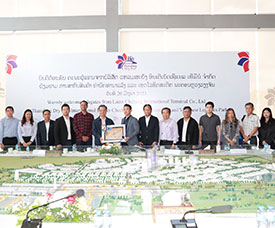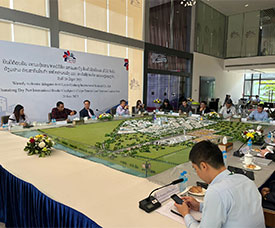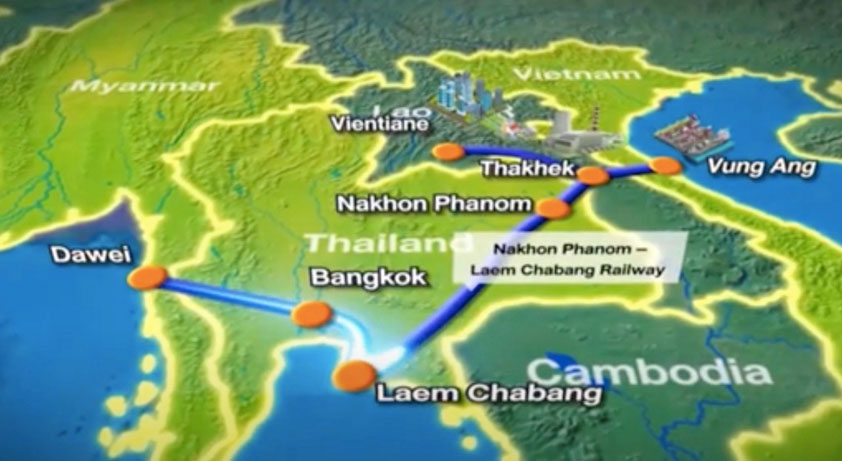Lao dry port, Thai seaport operators eye cooperation in cross-border freight shipment
Laos’ Thanaleng Dry Port and Laem Chabang International Terminal Co., Ltd. - the operator of two berths at the Laem Chabang seaport - are hoping to forge links to quicken the cross-border and transit shipment of freight.
The proposed link up comes as Laos is increasingly becoming an important trade gateway between Southeast Asia and China.
Functioning as a border checkpoint for freight, the dry port located in Vientiane is a converging point for the Laos-China and Laos-Thailand railways, which can link Southeast Asia to China with cost-effective services.
 |
 |
| Mr Viengkhone Sitthixay (right) presents a gift to Mr Phawinsak Phusit Wutikul. |
|
Through the China-Europe railway network, cargo from countries in the region could reach the European market within 14-21 days as opposed to 45 days by sea.
Welcoming a Thai business delegation headed by the Director of Laem Chabang International Terminal Co., Ltd., Phawinsak Phusit Wutikul, Viengkhone Sitthixay, the Vice President of Vientiane Logistics Park Co., Ltd., the developer of the dry port, said his company is seeking cooperation with the Thai side to capitalise on the opportunities offered.
He added that his company has invited Thai entrepreneurs from various sectors to discuss ways to improve logistics and transport services to handle the growing demand in trade and transport services in the region and beyond.
“In particular, we are aiming to facilitate services for Asean countries, Europe and China, which are huge markets,” he said.
“We want to increase cooperation in transport services and facilitation between our ports.”
Although it only became operational in December 2021, the multimodal transport node dry port, which is located in Vientiane, has handled a large volume of freight. Last year, almost 50,000 containers passed through the dry port to countries such as Thailand, Vietnam, Cambodia, Myanmar, Malaysia, Singapore, China and Russia.
Noting its rapid growth, the Thai director said there are great opportunities for cooperation, including connecting the two ports, given the huge volume of containers passing through Laem Chabang.
Almost 10 million CEUs (Container Equivalent Units) pass through the Thai seaport each year, he said.
“If [Laem Chabang] connects through Laos it will benefit both sides,” Mr Phawinsak said.
Laem Chabang International Terminal Co., Ltd.’s Chief Executive Officer, Alpesh A Sharma, said his company is interested in how Laos connects to China and Europe and beyond.
Mr Viengkhone welcomed Laem Chabang International Terminal Co., Ltd. to expand its services, including setting up a representative office at the dry port.
He added that the dry port has partnered with other ports and logistics service providers in the region, who can share useful information on marketing plan developments.
The Thai delegation was also scheduled to travel to Boten near the Chinese border and China’s Kunming - the end point of the Laos-China Railway - to survey the trade route.
More and more transport service providers in Thailand, a major farm goods producer, have shipped freight, mainly fruit, to China by rail via Laos. Cheaper transport enables them to cut transport costs by 30 percent compared to road transport, and speedy delivery brings fresher fruit to Chinese customers.
Mr Viengkhone told the guests the dry port is working with China to build an SPS (sanitary and phytosanitary measures) centre at the port. Once the SPS centre becomes operational, it will quicken the cross-border shipment of farm products. The dry port and its associated Vientiane Logistics Park is part of the planned package Lao Logistics Link project, which also includes the Vung Ang seaport in Vietnam’s central Ha Tinh province and a planned railway linking the seaport to the dry port.
Through Vung Ang, cargo can reach markets in the Pacific region.
Mr Viengkhone said his company is also developing a logistics complex to welcome entrepreneurs to do business in various fields. The complex comprises seven zones including a tank farm, export processing centre, logistics park, free trade zone, technology and halal hub, and administrative and office zone. Businesses manufacturing or assembling goods in Laos can enjoy privileged access to markets in countries whose governments have waived or reduced import tariffs on made-in-Laos products.
More than 30 countries including Australia, Canada, members of the European Union (EU 28), Japan, New Zealand, Norway, Russia, Switzerland and Turkiye have extended such privileges to Laos.
 |
The blue line indicates the link between the Thanaleng dry port to Laem Chabang sea port and other ports in the region. |
By Advertorial Desk
(Latest Update June 22, 2023)
|